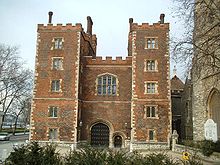| Revision as of 12:48, 5 August 2004 editBurschik (talk | contribs)Extended confirmed users4,827 editsm added category← Previous edit | Revision as of 23:36, 23 August 2004 edit undoFrancs2000 (talk | contribs)39,062 editsm dab TudorNext edit → | ||
| Line 4: | Line 4: | ||
| The south bank of the Thames, not part of historic London, developed slowly because the land was low and sodden: Lambeth Marsh it was called, as far downriver as ]. The name "Lambeth" embodies ''"hithe"'', a landing on the ]: archbishops came and went by water, as did ], who was tried here for heresy. | The south bank of the Thames, not part of historic London, developed slowly because the land was low and sodden: Lambeth Marsh it was called, as far downriver as ]. The name "Lambeth" embodies ''"hithe"'', a landing on the ]: archbishops came and went by water, as did ], who was tried here for heresy. | ||
| The oldest part of the palace remaining is the ] ]. The so-called ]’s Tower, which retains evidence of its use as a ] in the 17th century, dates from ]. There is a fine ] brick gatehouse built by ] in ] (''illustration, right''). | The oldest part of the palace remaining is the ] ]. The so-called ]’s Tower, which retains evidence of its use as a ] in the 17th century, dates from ]. There is a fine ] brick gatehouse built by ] in ] (''illustration, right''). | ||
| The Great Hall was ransacked by Cromwellian troops during the ], and after the Restoration it was rebuilt by archbishop ] in ] (dated) with a late Gothic ] roof, the likes of which had not been constructed for a hundred years. In this context, the choice of a hammerbeam roof was evocative; it spoke of High-Church Anglican continuity with the Old Faith (the King's brother was an avowed Catholic), a visual statement that the Interregnum was over. As with some Gothic details on University buildings of the same date, it is debated among architectural historians whether this is ''Gothic survival'' or an extraordinary early work of the ''Gothic Revival.'' The diarist ] recognized it for what it was: "a new old-fashioned hall" he called it. | The Great Hall was ransacked by Cromwellian troops during the ], and after the Restoration it was rebuilt by archbishop ] in ] (dated) with a late Gothic ] roof, the likes of which had not been constructed for a hundred years. In this context, the choice of a hammerbeam roof was evocative; it spoke of High-Church Anglican continuity with the Old Faith (the King's brother was an avowed Catholic), a visual statement that the Interregnum was over. As with some Gothic details on University buildings of the same date, it is debated among architectural historians whether this is ''Gothic survival'' or an extraordinary early work of the ''Gothic Revival.'' The diarist ] recognized it for what it was: "a new old-fashioned hall" he called it. | ||
Revision as of 23:36, 23 August 2004

Lambeth Palace is the palace of the Archbishop of Canterbury, located in Lambeth, in London on the Thames opposite the Palace of Westminster. It was acquired by the archbishopric around 1200.
The south bank of the Thames, not part of historic London, developed slowly because the land was low and sodden: Lambeth Marsh it was called, as far downriver as Blackfriars. The name "Lambeth" embodies "hithe", a landing on the Thames: archbishops came and went by water, as did John Wycliff, who was tried here for heresy.
The oldest part of the palace remaining is the Early English chapel. The so-called Lollard’s Tower, which retains evidence of its use as a prison in the 17th century, dates from 1440. There is a fine Tudor brick gatehouse built by John, cardinal Morton in 1495 (illustration, right).
The Great Hall was ransacked by Cromwellian troops during the English Civil War, and after the Restoration it was rebuilt by archbishop William Juxon in 1663 (dated) with a late Gothic hammer-beam roof, the likes of which had not been constructed for a hundred years. In this context, the choice of a hammerbeam roof was evocative; it spoke of High-Church Anglican continuity with the Old Faith (the King's brother was an avowed Catholic), a visual statement that the Interregnum was over. As with some Gothic details on University buildings of the same date, it is debated among architectural historians whether this is Gothic survival or an extraordinary early work of the Gothic Revival. The diarist Samuel Pepys recognized it for what it was: "a new old-fashioned hall" he called it.
The portion of Lambeth Palace now inhabited by the archbishop was built in 1834 by Edward Blore (1787-1879), who rebuilt a lot of Buckingham Palace later. Here his work is neo-Gothic enough to have satisfied Sir Walter Scott, and it fronts a spacious quadrangle. Among the portraits of the archbishops here are examples by Hans Holbein, Anthony van Dyck, William Hogarth and Sir Joshua Reynolds.

There is a valuable library the official library of the archbishops of Canterbury, founded as a public library by archbishop Richard Bancroft in 1610, the principal holder of records for the history of the Church of England.. Beyond ecclesiastical history, its rich collections are important for an immense variety of topics from the history of art and architecture to colonial and Commonwealth history, and for innumerable aspects of English social, political and economic history. It is also a significant resource for local history and genealogy. (see link below)
The church of St Mary was rebuilt around 1850, though the ancient monuments preserved give it an appearance of antiquity. Amongst them are tombs of some of the archbishops, including Richard Bancroft, and of the gardeners and plantsmen the two John Tradescants, father and son. The Museum of Garden History is located at Lambeth Palace, because of its Tradescant associations.